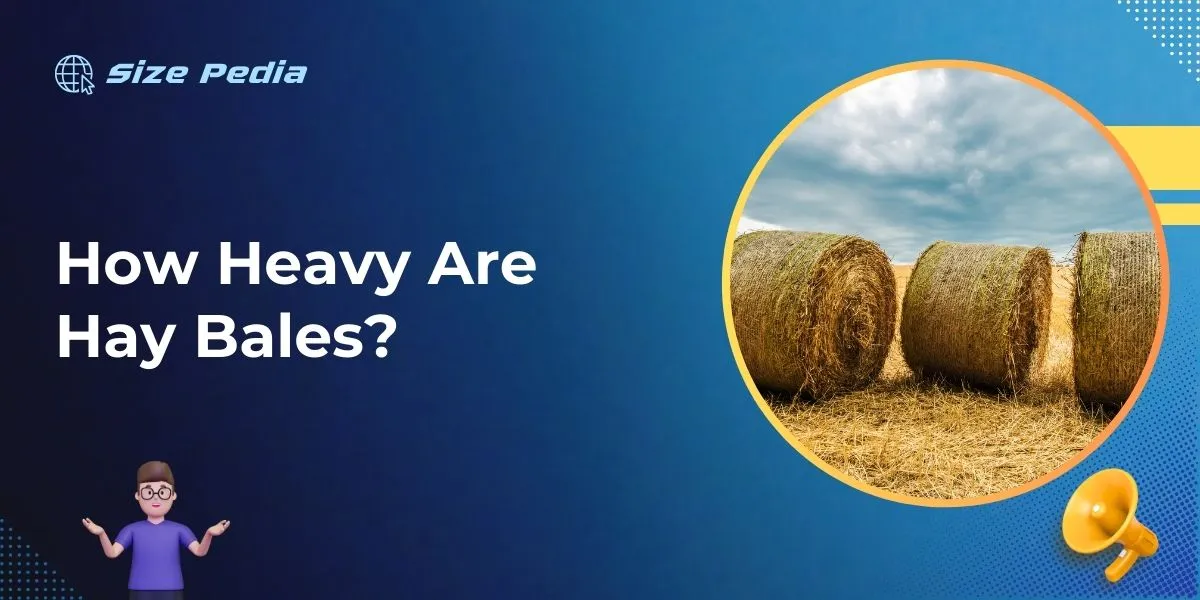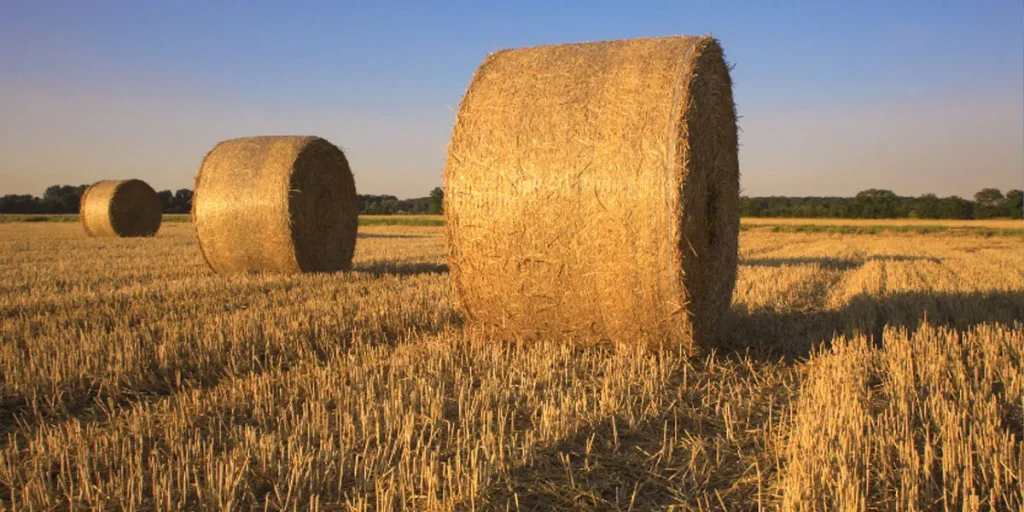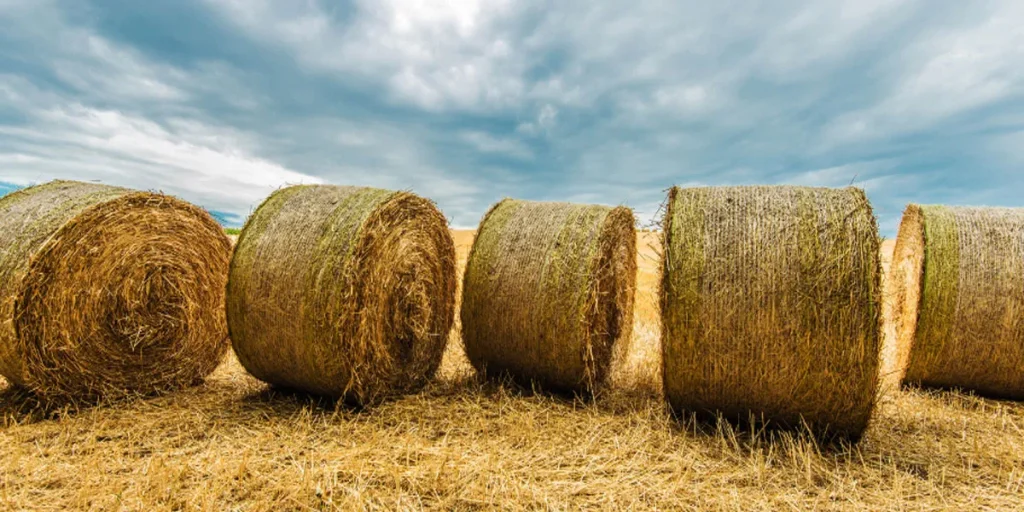Small square hay bales typically weigh between 40 to 75 pounds, while large round bales can weigh 800 to 2,400 pounds. The precise weight depends on the hay’s moisture content, density, and the bale’s size.
Understanding the weight of hay bales is critical, especially for those in the agricultural and transportation sectors.
Hay bales come in various sizes and shapes, with the most common being the small square and large round bales.
Their weight plays a significant role in determining transportation costs, storage requirements, and feeding plans for livestock.
Farmers and transporters alike must account for these factors when managing hay.
With the right knowledge of hay bale weights, proper planning can ensure efficient and cost-effective handling of this vital agricultural product.

Varieties Of Hay Bales
Hay bales come in various shapes and sizes, each serving different needs. Farmers and livestock owners often choose based on storage capabilities, animal feed requirements, and handling convenience.
Becoming familiar with the common varieties of hay bales helps in making informed decisions for agricultural or equestrian needs.
Small Square Bales
Small square bales are popular among small farm owners and horse enthusiasts. They are easy to handle and perfect for small-scale use. Typically, these bales weigh between 40 to 60 pounds. Here’s a quick look:
- Size: Usually around 14″x18″x36″
- Weight: 40-60 lbs per bale
- Usage: Ideal for individual horse feed
- Storage: Suitable for smaller barn spaces
Large Round Bales
For those with more extensive operations, large round bales are a go-to. Their considerable size requires machinery to move. A standard large round bale weighs in the ballpark of 600 to 1,500 pounds.
| Diameter | Width | Weight Range |
|---|---|---|
| 4-6 feet | Width varies | 600-1,500 lbs |
Feeding large herds becomes more manageable with these bales. They also stay well outdoors.
Big Square Bales
Big square bales strike a balance between the prior two types. Easy to stack and transport, they have found favor with commercial farmers.
These large blocks can tip the scales at 500 to 2,000 pounds.
- Dimensions: 3x3x8 to 4x4x8 feet
- Weight: Ranges from 500-2,000 lbs
- Stacking: Efficient for storage
- Handling: Requires equipment
These bales are preferred for consistent quality and feeding efficiency.
Factors Influencing Hay Bale Weight

Ever wonder why hay bales come in different weights? It isn’t just about size. Various elements impact a bale’s heaviness. Let’s unwrap these factors.
Hay Type And Quality
Different hay types have unique weights. For example, alfalfa is heavier than grass hay. Also, high-quality hay is denser, making it weigh more.
- Alfalfa: Heavier due to denser leaves
- Grass hay: Lighter, more air-filled
Moisture Content
The moisture level influences weight too. Wetter hay means heavier bales. Ideal moisture levels are between 15-20%.
| Moisture Level | Hay Bale Weight Impact |
|---|---|
| <15% | Lighter, dry |
| 15-20% | Ideal weight |
| >20% | Heavier, risk of spoilage |
Baling Techniques
How hay is baled also affects weight. Tighter bales are heavier. The time of day and the baling equipment used both play roles.
- Morning baling can capture more moisture.
- Evening baling often results in drier hay.
- Modern balers compress hay more efficiently.
Average Weights Of Hay Bales

Farmers and livestock owners often ask about hay bale weights. These weights vary. Bales come in different sizes and shapes.
Let’s dive into the details of how much hay bales weigh.
Typical Small Square Bale Weights
Small square bales are popular. They’re easy to handle. They often weigh between 40 to 60 pounds (18 to 27 kg).
This can vary depending on moisture content and the type of hay. Let’s look at some common weights:
- Timothy Hay: Usually around 50 pounds
- Alfalfa Hay: Could be slightly heavier, approximately 60 pounds
- Mixed Hay: Often fall in the 40 to 60-pound range
Common Large Round Bale Weights
Large round bales save time in feeding. They’re commonly found on big farms.
A large round bale typically weighs around 1,200 to 1,500 pounds (544 to 680 kg). Some key points include:
- Weight is affected by density and size
- Average diameter is about 5 to 6 feet
- Width can be around 4 to 6 feet
Standard Big Square Bale Weights
Big square bales work well for efficient stacking and transport. A standard big square bale can weigh from 500 to 1,000 pounds (227 to 454 kg).
Their dimensions and weight make them a favorite choice for large-scale farming operations. Here’s a quick breakdown:
| Type | Average Weight |
|---|---|
| 3x3x8 Bale | 700 to 900 pounds |
| 3x4x8 Bale | 1,000 to 1,200 pounds |
| 4x4x8 Bale | 1,500 to 2,000 pounds |
Importance Of Knowing Hay Bale Weight
The ability to weigh hay bales accurately is crucial for various reasons.
Knowing the precise weight assists in planning and decision-making across different aspects of farm and business operations.
From the transportation of hay to managing livestock feed requirements, the weight factor plays a significant role.
Transportation Logistics
Transporting hay bales efficiently requires knowing their weight.
This information ensures safe loading capacities for transportation vehicles and helps prevent potential road violations related to overweight loads.
- Optimizes truckloads: Accurate weights allow for maximum usage of space without exceeding weight limits.
- Reduces costs: Knowing the weight can help avoid additional charges for exceeding weight restrictions.
- Ensures safety: Proper weight distribution avoids accidents and vehicle strain.
Livestock Feed Management
For livestock farmers, feed control is critical. Weight knowledge supports accurate feed rationing, ensuring that each animal receives sufficient nutrition.
| Animal Type | Hay Weight/Day | Days Covered |
|---|---|---|
| Cattle | 20 lbs | 30 |
| Sheep | 5 lbs | 60 |
A precise hay bale weight also prevents waste and optimizes feed usage.
Economic And Business Considerations
For the business-minded, understanding hay bale weight has direct economic implications. It plays a key role in:
- Pricing strategies: Accurate weight enables fair pricing and helps to determine profit margins.
- Budgeting: Feed constitutes a major part of the livestock business budget. Correct weight helps in effective budget planning.
- Inventory management: Knowing the weight assists in track stock levels and plan for future purchasing needs.
In short, the weight of hay bales is a vital metric that impacts various facets of agricultural operations.
Methods For Weighing Hay Bales
Farmers and ranchers often need to know how heavy their hay bales are. This helps in managing feed supplies and in selling hay.
There are different ways to find out the weight of a hay bale. Here are some methods.
Scales And Balances
Using scales is a common way to weigh hay bales. There are different types:
- Farm scales: Large platform scales that can handle big loads.
- Loader scales: Attached to a tractor or forklift, these scales weigh a bale as it is lifted.
Scales give an exact weight, so they are trusted by many farmers.
Estimating Techniques
Not everyone uses scales. Some guess the weight. They might look at the size or feel how heavy it is. Here are common ways:
- Measuring the bale and using standard weight estimates.
- Feeling the weight through experience.
These are fast and easy but not always precise.
Industry Innovations For Measurement
The industry keeps making new tools to measure hay bales. These include:
- Smart scales: They send weights to computers or phones.
- RFID systems: They track the weight of each bale with a tag.
These new tools help farmers get weights quickly and accurately.
Effect Of Bale Weight On Quality And Storage
Understanding how the weight of hay bales impacts storage and quality is crucial. Hefty bales require careful considerations.
Lighter bales may ease the handling process. But weight variation can influence nutritive content, preservation, and feeding practices. Let’s explore these critical areas.
Impact On Nutritional Value
Bale weight directly affects nutritional consistency within hay batches. Dense bales preserve nutrients better over time due to reduced exposure to air and moisture.
Lighter bales, exposed to the elements, might degrade faster. Proper weight ensures optimal feed value during storage. It also reduces spoilage risks.
Storage Space And Preservation
- Heavy bales maximize space use. They stack efficiently, leaving less air space.
- Optimal bale weight enhances stack stability.
- Consistent weight leads to better air circulation, preventing moisture entrapment.
- Reduced waste occurs with correctly weighted and stored bales.
Handling And Feeding Efficiency
| Bale Weight | Handling Difficulty | Feeding Ease |
|---|---|---|
| Heavy | Higher | Lower |
| Medium | Moderate | Moderate |
| Light | Lower | Higher |
Heavier bales may need machinery to move and feed. Light bales improve manual handling. Nonetheless, weight consistency across bales streamlines feeding routines and minimizes labor.
FAQs About the Weight of Hay Bales
What Is The Average Weight Of Hay Bales?
The average weight of small square hay bales is around 40 to 60 pounds. Large round bales can weigh between 500 to 1,500 pounds, depending on size and density.
How Do Hay Bale Sizes Impact Weight?
Hay bale sizes greatly impact weight. Small square bales typically weigh less, ideal for hand feeding. Large round or rectangular bales can weigh significantly more, designed for mechanical handling.
Can Hay Bale Weight Vary By Type?
Yes, hay bale weight can vary by the type of hay. For example, a bale of alfalfa usually weighs more than a bale of grass hay due to higher moisture content and density.
What Factors Affect Hay Bale Weight?
Factors affecting hay bale weight include moisture content, bale size, type of hay, and the compression rate used during the baling process. Denser bales tend to weigh more.
Conclusion
Understanding the weight of hay bales is crucial for proper handling and storage. Small square bales might weigh around 40-60 pounds, while large round ones can tip the scales at 1500 pounds or more.
Whether you’re a farmer, a hobbyist, or just curious, always handle hay with the right knowledge to ensure efficiency and safety.
Embrace these insights for a smooth agricultural experience.
Resources:
https://www.crowwing.gov/DocumentCenter/View/759/Straw_or_Hay_Bales?bidId=
https://www.epa.gov/system/files/documents/2021-11/bmp-straw-or-hay-bales.pdf
